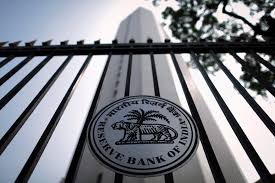RBI holds rates; cheers markets by trimming inflation view

MUMBAI (Reuters) – The Reserve Bank of India kept its policy rates on hold on Thursday and retained its “neutral” stance but lowered its inflation call, reducing the odds of a near-term rate rise and spurring a rally in stocks and bonds.
The RBI kept its policy repo rate unchanged at 6.00 percent for the fourth straight meeting as unanimously expected by 61 respondents in a Reuters poll. That level is the lowest since November 2010.
It also kept the reverse repo rate unchanged at 5.75 percent.
Five of six members on the monetary policy committee (MPC) voted for a hold, while one wanted to raise the repo rate.
The MPC sharply trimmed its April-September inflation projection to 4.7-5.1 percent, from a previous range of 5.1-5.6 percent that it released in February.
Rajni Thakur, an economist at RBL Bank, termed the high growth and low inflation projections a “Goldilocks scenario” that could “very well indicate rates on hold for the whole year”.
Inflation concerns have eased substantially in recent weeks following a crash in vegetable prices, which are expected to keep price pressures soft for the next few months. Oil prices remain a risk however, with India importing roughly 80 percent of its crude requirements.
Bonds rose after the RBI statement to their highest levels since early January, while the rupee firmed slightly and stocks extended early gains with state banks rising sharply.
The 10-year benchmark bond yield fell to 7.13 percent, the lowest since Jan. 9, and compared with its previous close of 7.29 percent, while the rupee was trading at 64.9650 to the dollar from 65.15 at Wednesday’s close.
The state-run bank index jumped 4.9 percent and the main market index closed up 1.94 percent.
STRONGER GROWTH
The RBI projected economic growth of 7.4 percent for the current fiscal year that began on April 1, sharply higher than its projected 6.6 percent for the last fiscal year that ended in March, saying “several factors are expected to accelerate the pace of activity”.
The government had said in its budget announcement in February that it aimed to achieve 7.0-7.5 percent growth in the current fiscal year.
The RBI warned, however, that even as global growth and trade have strengthened, rising trade protectionism and market volatility could derail the global recovery.
India regained its status as the world’s fastest growing major economy in the October-December quarter, expanding by 7.2 percent as government spending, manufacturing and services all picked up.
But many economists doubt whether that pace can be sustained.
INFLATION UNCERTAINTIES
The MPC said it saw inflation in the second half of this fiscal year at 4.4, but that was without taking into account any increase from higher housing allowances to government employees.
After hitting a 17-month high in December, retail inflation eased for the second straight month in February, to a four-month low of 4.44 percent. But it remains higher than the RBI’s medium term target of 4 percent.
That has prompted most market watchers to push back their forecasts for a rate increase to early 2019, from earlier forecasts of the second half of this year.
“We don’t anticipate a change in the repo rate, or stance of monetary policy until greater clarity emerges towards the second half of the year on the impact of minimum (crop) support prices and monsoon on the inflation trajectory,” said Aditi Nayar, the principal economist of rating agency ICRA.
While inflation fears have eased in the short term, the RBI sounded cautious and opted to wait for more data instead of giving a clear indication of its policy path.
The “inflation print for February did turn out to be softer than our projection,” the central bank’s governor, Urjit Patel, told media after the policy decision.
“However (the) MPC looks ahead. We noted there are several uncertainties around the baseline inflation path which is why we’ve kept our stance neutral and rate unchanged.”
The MPC reiterated its commitment to achieving the medium-term target for headline inflation of 4 percent on a durable basis.


